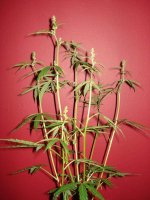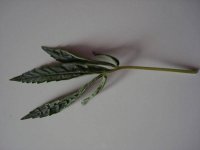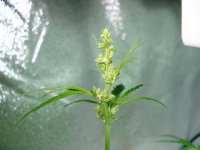CVH, that was a good idea to try and spin off the conversation to preserve this one and keep it on topic, but it's not a thread I want to be part of.Hi guys, you're all so very knowledgeable and experienced. I'm jealous.
But would it be possible to continue the debate about opiumnated Thai sticks in the thread linked below?
It makes it easier for everyone on the forum who wishes to follow the debate.
You guys post to many good info about it into this haze thread. It would be a shame to see all your posts about this subject become unfoundeable.
Opiumnated Thai Sticks: Myth or Truth?
https://www.icmag.com/ic/showthread.php?t=373835
Thanks.
I think the only one that WANTS to talk about this is Hempy. It's not provable. Some will believe it, some won't.
Hempy, I have never thought or said you are a liar. I agree with what Donald said about you. Loyal and honest. You truly believe your interpretation of what you see and hear and then repeat it for others.
What I have an issue with you so often about is the lack of critical thinking that you apply to these old myths and legends. And a lot of these bits of "knowledge" took root in your mind soooo many years ago. You attach your self-respect to these things, and when anybody questions you about the validity of them (something you yourself should have done long ago, and often since then as new information comes out all the time) you take the question as an attack on your integrity instead of questioning your own long held assumptions.
Critical thinking Hempy.
Things like posting a picture of what is obviously an old stick of commercial incense as an example of Thai Stick cannabis, just because the source was the US DEA.
You have to use your own eyes man. Question the label. Hell, question everything. These days, more and more people have realized they need to do that as so little is what it appears.
The reason people are debating the opium+thai stick myth so much is because there are people who repeat the story as as a massive generalization: "Thai weed was so powerful because it was adulterated with opium."
Myths like that spread by people who have never smoked Thai weed or opium eventually become "facts" in this world.
People who really care about cannabis have a hard time sitting silent then they hear that.
Assuming that cannabis and opium are produced by completely different groups of people, one thing that doesn't make sense to me is transporting large quantities of (illegal) opium production waste product at great risk to add to a crop of good flowers.
All of us should know that any time you transport illegal substances, it is a high risk event and should be avoided unless absolutely necessary.
It made me curious enough to do a single web search where I found this 1992 US NIJ document:
Opium Poppy' Cultivation and Heroin Processing in Southeast Asia
It covers a lot of great detail about the who, where, and how of opium production in Burma, Thailand and Laos.
Although production (apparently) happens in some of the same areas known for Cannabis and even some of the same ethnic groups, the document describes other crops typically planted in conjunction with poppies and does not mention cannabis at all.
It includes complete descriptions of the process from farming to refinement.
Tell you the truth, after reading it I didn't see a single waste product that looked like a candidate for adding to cannabis to improve it except possibly raw opium itself, diluted when dissolved in boiling water. Poor slash and burn subsistence farmers in the hills can't afford to buy opium to add to a messed up crop which will then sell for the same price as the opium they added to it.
The references to what was sold to GIs in Vietnam seems to me to be a product that would be created by street dealers, not smugglers.
There is a difference between what gets sold by street dealers and what is sold by the boat load for export. Street dealers often have to deal with how to make money from bad batches of product. Old weed, moldy weed, shit harvested too early, or just badly grown. It all makes it to market eventually and a sucker is born every minute. But if you are risking a fortune in cash and life behind bars to load a a freighter with bales to sell on the other side of the world. . . you get "the good stuff." As good as you can find.
It's easy to imagine a street dealer who finds himself stuck with a bad batch of weed, thinking "what can I add to this crap to get people to buy it?" Get some raw opium, boil it in water. Dip/pour/soak the shit weed quickly in the sauce and spread it out do dry in the tropical heat.
Then, sell it to stupid Americans who will buy anything to stop thinking about the misery of their life killing people far from home for something that has nothing to do with them.
That all makes sense right?
What doesn't make sense is taking the risk of exporting weed around the world that wasn't good enough to sell on it's own quality.
From a perspective of "Name those (criminal) charges", I ask the question: What do you get when you coat ten thousand kilos of Thai stick with 100 kilos of opium?
Answer: Ten thousand one hundred kilos of OPIUM.
That's what law enforcement would do, and the jail sentence would be much greater for anyone caught with the opium sticks vs plain thai weed.
When Dr. Purpur says he smoked plenty of imported Thai with opium back in the day, I have to take notice. One because I know the Doc to be a critical thinker who takes nothing for granted, and two because he lived and partied in one of the top smuggling destination port cities for Thai sticks at the time in question.
Again, assuming that adding opium to Thai weed is something that a dealer would do if he found himself holding a large quantity of low grade weed, opium is certainly something that would be available in large quantities in San Francisco. I think it's not unreasonable to assume that a product like that might exist on the street here and there.
A street dealer solution to a batch quality problem. That is my logical assumption if the stuff ever existed at all.
This thread is way off topic. Maybe we should rename it?
I know my thoughts are pretty jumbled around up there, but I've spent enough time on this. Although I feel a little better informed about opium in SE asia from my searches and enjoyed hearing some of the first hand accounts, I know this is a debate that will never end, so I'll leave it to others.
Last edited:












